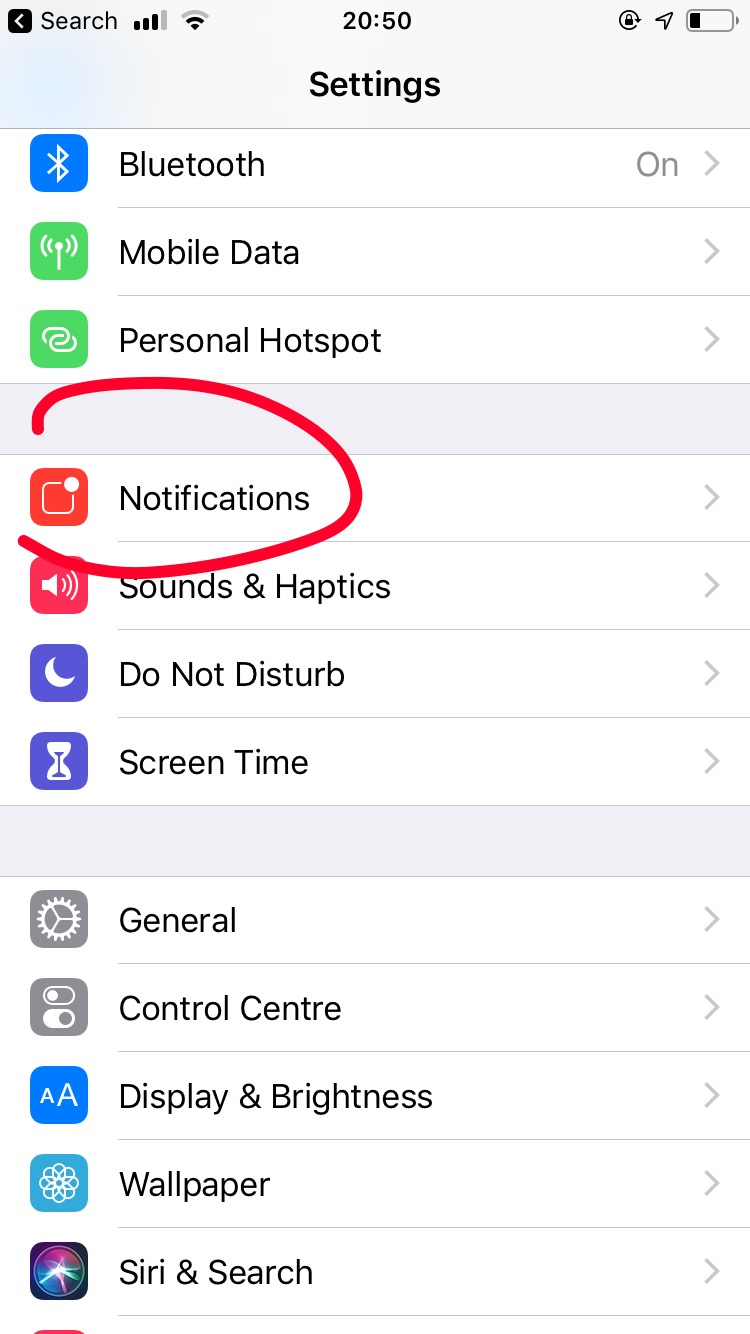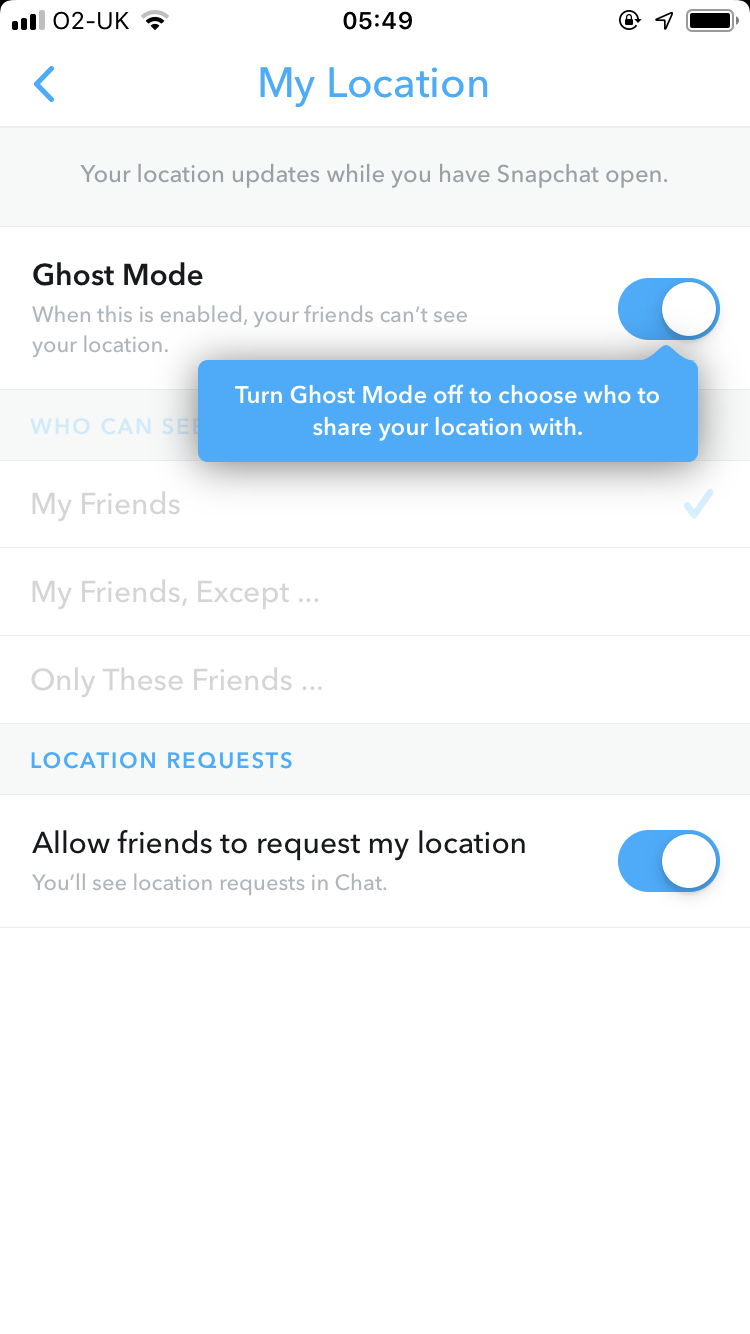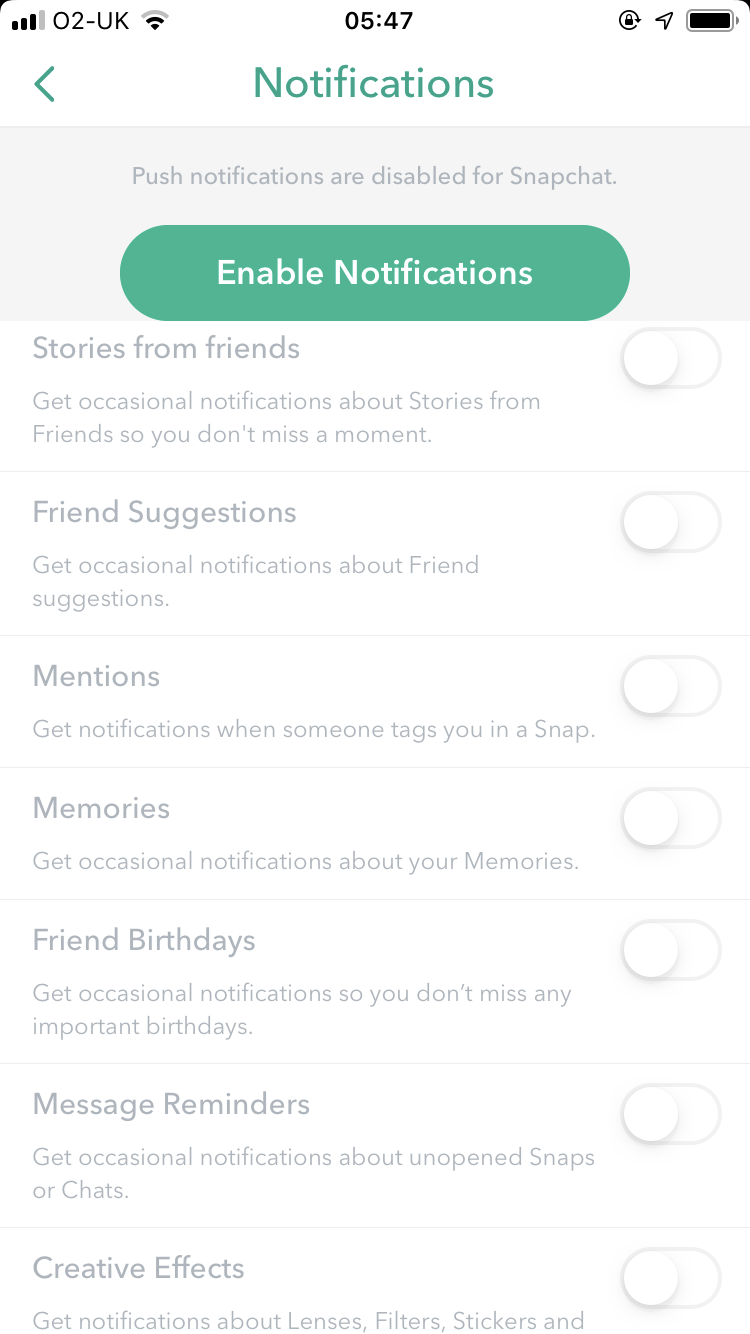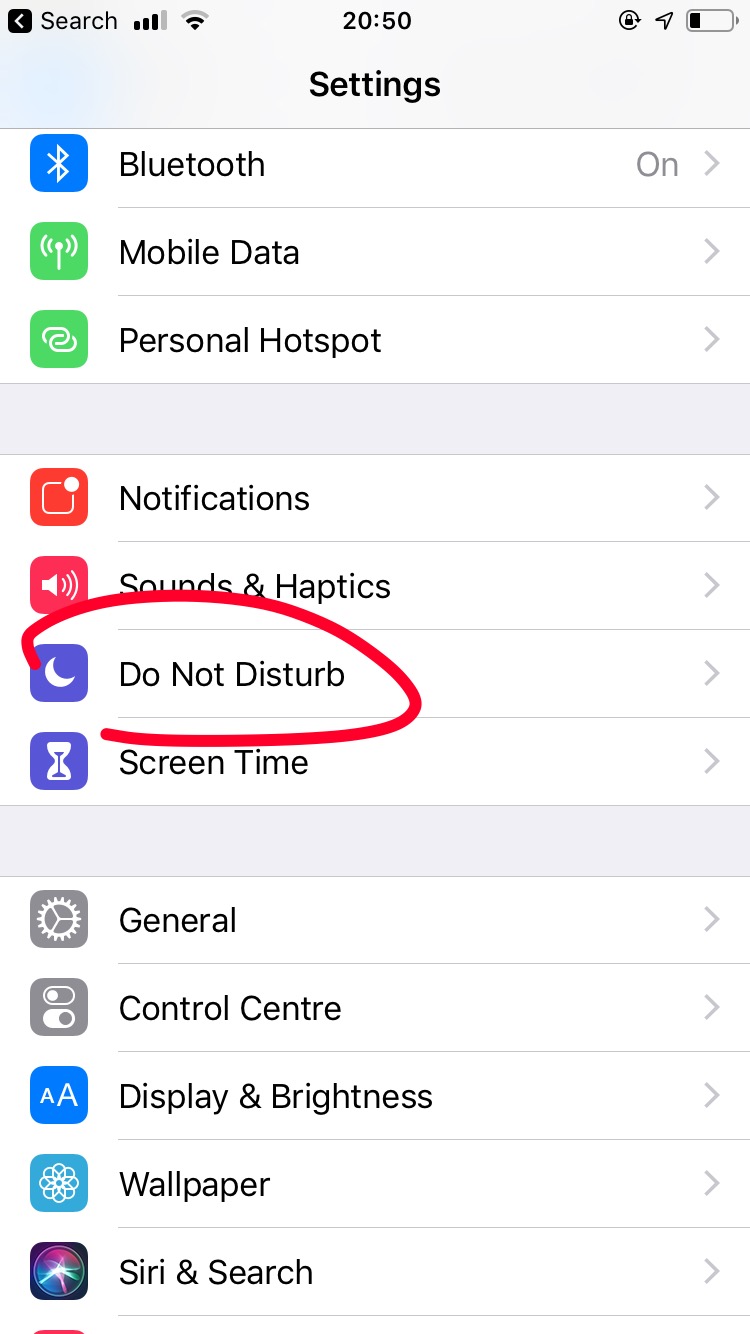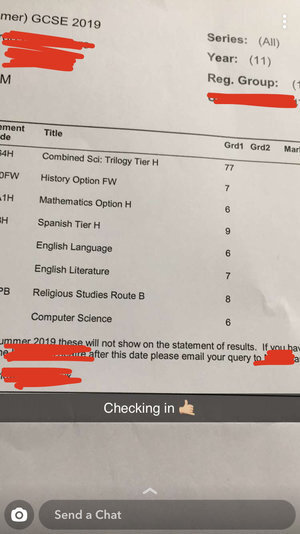Exam Solutions: How To Set Up Your Smartphone For Exam Success
Contents
Understanding The Attention Economy
How it works
Free apps
Paid apps
What’s the best way to ‘win’ as a user within the attention economy?
Digital Nutrition
Push notifications example
Snapchat example
Turning off (almost) all notifications
Ensure notification badges are turned off
👆Why this is so important
Hiding social media slot machines
Hide messaging slot machines
Turn on do not disturb
Be strategic about your wallpaper
Turn off raise to wake
Add content restrictions
Turn off advertising tracking
Download three key apps
Introduction
If you find yourself regularly picking up your smartphone, checking your usual apps (with or without notifications present), and then feeling crummy about having completed another 2 hour cycle of tapping, swiping, watching, texting and mindless procrastination…This post is for you.
On a personal level, I first became more conscious about the way I used my smartphone, and more specifically, how it was set up by default, whilst I was working at VaynerMedia. Here I spent just over 2 years helping big companies capture the attention of potential customers online through persuasive advertising.
Now I see almost everything to do with the smartphone in terms of attention traded as an online currency. Therefore, in this guide, I’ll show you how to set up your smartphone to make the best ‘investments’ towards achieving a great set of exam results.
“Compound interest is the 8th wonder of the world.”
- Albert Einstein
As a financial adviser would do, I’m going to recommend the earlier you can start making the changes to the way you think about your smartphone, how you set it up and, as a result, how you use it, the better. This is because well thought through investments of attention will compound over time, you will be selling high, buying low and using the new skills and knowledge aquired to build an increasingly advantageous position for yourself within the attention economy on the smartphone.
How To Use This Guide 🤔
My advice here would be to skim read the article at first in order to get a broad sense of the stages within the set up process.
On the second time around throw the article up on a desktop, tablet, another smartphone or another tab on your smartphone and systematically make the changes.
It’s going to feel weird at first, just like when you try anything new for the first time. You’re going to have to break down some existing beliefs you have about your smartphone and take a more proactive approach dictating how you want it to function.
After a while this will become second nature, but you need to give yourself the best chance of success possible by methodically completing the initial set up.
Overview Of The Set Up
There are five stages to a solid smartphone set up during exam season.* I’ll walk you through all of them in detail, but first, let’s be clear on what they are:
Defining The Purpose Of Your Smartphone
Clearly define what the purpose of your smartphone is during exam season
Understanding The Attention Economy
Understand the key elements of the attention economy created by apps on the smartphone
Asking Great Questions
Ask specific questions to determine what will be included and excluded in terms of your smartphone set up. This will also provide a framework for making any updates to your set up in the future.
Making Changes
Execute the changes (I’ll include screenshots showing how to do this).
Adjusting Accordingly
Allocate time for regular checkins to determine whether your smartphone is fulfilling the role you want it to play during exam season and then adjust accordingly.
*Exam season is defined as the 2-3 months before and during your exams when you realise you need to prioritise school work over most of the other things you like doing year round. This doesn’t mean giving those things up, it just means you need to tweak your schedule to reflect greater prioritisation of activities which contribute to your exam success. Short term pain. Long term gain.
1. Defining The Purpose Of Your Smartphone
“We are oppressed by our electronic servants, and this book is dedicated to our liberation”
– Jef Raskin author of The Humane Interface
The first time I heard this quote it was read aloud by Aza Raskin, Jef’s Son, at the start of a talk hosted by The Center For Humane Technology. It struck a chord with me and I began to think through how it could be both proved and disproved when applied to the smartphone.
Here’s where Jef might appear wrong...
Let’s go back in time and assess Jef’s quote against the historical development of the smartphone…
At first, the phone, not yet ’smart’ was designed to allow two people to communicate with each other whilst not physically present. It solved a BIG problem.
As phones became smart they took on all kinds of extra utility to better serve the human user. For example, multimedia messaging, scheduling, social media, video on demand, health tracking, education, gaming and the thousands of other Swiss army knife-like things you can do with a smartphone…Yes it can even be used as a torch light!
At face value the smartphone does appear to be our servant. We are not oppressed, nudged, persuaded, manipulated or psychologically hacked in any way. We are in control, extracting utility and convenience from this incredible device.
Therefore, the purpose of the Smartphone appears to be:
To make our lives easier and more enjoyable.
This broad purpose can also be applied within specific context of exam preparation. .
For example:
Easier planning and note taking (eg. Google calendar and Evernote)
Motivational/inspirational resources (eg. Specific social media pages)
Faster and more effective revision (eg. Revision apps driven by Artificial Intelligence)
Provision of exam related resources online (eg. Past papers, mark schemes, syllabi)
Online advice, tips and knowledge sharing (eg. The Exam Coach 😉)
More enjoyable ways to learn (eg. Educational videos, memes, games)
By this logic we should all just download the relevant apps required and put our smartphones to work for us.
BUT, we all know this is easier said than done.
To gain a better understanding of how things work in reality we need to understand what happens when a tool like the smartphone is combined with the capitalist system of economic governance which dominates the majority of the world we live in today.
This brings us on to the next step…
2. Understanding The Attention Economy
“In the attention economy, anyone trying to connect with an audience must treat the user’s time as the ultimate resource”
- Jakob Nielsen, ex Sun Microsystems and Founder of usability consulting firm The Nielsen Norman Group
Read that quote twice because it’s at the core of what I’m about to go into...
Here’s why Jeff is very, very, right…
I’d like you to think of your smartphone like a door. After all, it’s shaped the same way. Just like a door it grants you access to something. Specifically, your smartphone grants you access to an environment where:
There’s a defined amount of screen space
There are three essential communication mediums (images, written word, audio)
In this way, an attention economy is created.
Here’s how it works:
Source: Will Schoder - he’s also created a great explainer video
Apps compete for your finite attention (the currency)
They do this by communicating images, written word and audio (products)
All of it happens within the screen space (the market)
Once an app has gained your attention they can then transform this virtual currency into real currency by packaging up your attention as a product to be sold to advertisers or by directing you to a place where you can purchase a product online.
Here’s why the purpose we decided for the smartphone in stage 1 (to make our lives easier and more enjoyable) and the attention economy are conflicting ideas…
Just because something spikes your curiosity, catches your eye, interests you or notifies you via your smartphone does not mean it should be objectively categorised as something which makes your life easier and more enjoyable. In fact, we should always doubt the intent of notifications on our smartphones since every app is financially incentivised to keep you using it for as long as possible. Just because you are using an app for extent periods of time does not mean it is making your life easier and more enjoyable when assessed from an objective, rational, long-term point of view.
The next three bullet points explain the inner workings of this statement. 👆
Free Apps
Free apps which rely on advertising to monetise make more profits when you spend more time on their app. This is how it works…
In terms of data:
The more time you spend on the app, the more actions you are likely to take (eg. taps, swipes, likes, comments)
The more actions you take the more data apps can collect on you (eg. interests, preferences, types of content you look at regularly etc.)
The more data collected on your the more targeted the advertising offering can become (eg. this person likes Barbies)
The more targeted the advertising offering the more apps can charge advertisers for access to this data because the advertising is more likely to deliver financial return for the advertiser. (eg. an advertiser selling t-shirts to teenagers will pay more for an audience proven to be teenagers and like t-shirts, rather than an audience of just teenagers)
In terms of advertising inventory:
The more time you spend on an app, the more actions you are likely to take (eg. taps, swipes, likes, comments)
The more actions you take the more advertising inventory becomes available (this is available ‘product' created for advertisers to buy eg. SnapAds, IG Stories ads, Facebook news feed video ads)
The more advertising products the app has available to sell the more sales and profit it makes. This is simple supply and demand, by spending more time on the app you increase advertising product supply which is in demand from advertisers.
Paid Apps
What about apps which don’t monetise through advertising?
Let’s say it’s an app you have to buy, or pay a subscription fee for, or one which you can buy physical products through. Though these apps aren’t incentivised to capture and hold your attention as heavily as free apps relying on advertising, it is still in their interests for two reasons:
The more time someone spends within an app the more likely they are to make a purchase.
Increased time spent within an app will make a user more likely to introduce the app to their friends via online sharing or word of mouth.
In this way, it’s clear that every app on a smartphone is financially incentivised to keep you using it for as long as possible. Which brings us to our next question….
What’s the BEST way to win within the attention economy?
So, capturing attention is crucial. But surely the best way to do this is to provide an easy and enjoyable experience for people? Who wouldn’t want that? Yes, this would probably work quite well. But it isn’t the most effective way of capturing attention and keeping it.
The most effective way involves elements of app design which exploit deeply engrained human psychological or cognitive biases. Simply offering to make our lives easier and more enjoyable isn’t enough to win in the attention economy. App designers has discovered that interfaces which appeal to the addictive, compulsive and subconscious parts of our psychology hook human attention most powerfully. Without getting too philosophical, this is very different from making our lives easy and enjoyable.
Here are a few examples of app design features and the psychological biases they appeal to:
The like button (social approval bias)
Push notifications (variable reward bias)
Swipe down to refresh feed (variable reward bias)
Snap streaks (reciprocation bias)
Message received/read (reciprocation bias)
Follower and comment counts (social proof bias)
Photo filters and lenses (neuroesthetic bias)
Layer on top of this overwhelming artificial intelligence which is constantly trying to serve you content you will spend the most amount of time on, you’re up against companies which can out predict and out smart your own brain. It’s chess against the human mind. Remember, Deep Blue was eventually able to defeat Gary Kasparov.
Side note: I’ll create another post diving deeper into the biases listed above.
The design elements above (compounded by AI) limit human choice and free will by creating a user experience which is often beyond our conscious control.
Here’s an example which you might be able to relate to:
Do you ever find yourself picking up your smartphone, opening the lock screen, tapping on one of your most visited apps and then a minute or two later wondering how or why you got there?
I do.
What I’ve come to realise is that this behaviour has been trained in us all. After a while our smartphone can get us to do stuff without us consciously thinking about what we’re doing. The good news is, the data shows that most of you guys are coming round to this realisation too.
In a report by Common Sense Media (2018) they found 72% of teens believe tech companies manipulate them to spend more time on their devices.
Once we understand what is really happening we are in a better position to make a change. So, it looks like Jef Raskin was right, we are oppressed by our electronic servants.
Clarifying making life easier and more enjoyable via the Smartphone…
An important note here is that it’s not that life doesn’t feel easy or enjoyable during the time our attention has been grabbed by something on the smartphone.
In the moment it feels great, all the way from the urge to check your phone, finding that something is there for you, discovering what it is and enjoying the dopaminergic ups and downs which follow.
It’s when we take a step back and look at the bigger picture and assess what we actually want to do with our lives where things become problematic
Digital Nutrition
To explain the bigger picture, I want to introduce you to an important metaphor which I personally use to navigate my own way around the attention economy.
I first came across this idea on the blog of Australian psychologist, Jocelyn Brewer. It’s called Digital Nutrition and it encourages us to think of everything on our smartphones just like food.
No, I’m not talking about edible messages or sweet smelling snaps, though that would be pretty cool. It’s about applying the model we use to think about our physical diets to the online world of media and content.
Here’s my summary of the concept:
Each piece of media on your phone has different nutritional qualities. Some things are going to make you feel sluggish and unhealthy, others vibrant and energised. Some will make you live happier and healthier. Others will leave you sad and feeling unwell.
For example, much of the content within the attention economy can be viewed in just the same way as fast food or sweets.
They’re easy to get.
They don’t cost you much.
They feel great in the moment.
You usually end up feeling crappy afterwards.
We all know all know devouring sweets and fast food all the time is no way to live because we will inevitably encounter health problems further down the line - science has proven this. (I don’t even need to link to a scientific study, it’s just the truth)!
What we’re less educated about is what poor ‘digital nutrition’ can do to our health.
Just like people had a hunch smoking or fast food might have addictive qualities (think nicotine and sugar) and negative consequences for our health (think lung cancer and obesity), the same investigative process is happening with the smartphone now.
Studies are being conducted to figure out what health implications particular types of smartphone usage might have. Scientists are gradually figuring out people’s ‘screenomes’ - how people are shaped by the way they use their smartphone (basically, what they’re looking at/doing on it most of the time).
But our relationship with the smartphone is more nuanced than smoking or nutrition. This is for the following reasons:
1). Negative health effects of smartphone use are usually less visible
2). The benefits of healthy smartphone usage far outweigh the benefits of fast food and smoking
3). We do not (yet) have a language to effectively talk about and communicate what healthy smartphone usage looks like. Think about expressions such as ‘5 a day’ for fruit and veg consumption or the cancerous images you see on packets of cigarettes… One reason for this could be because much of what impacts us on our smartphones is subjective, the user’s interpretation of the content results in it having wither a positive or negative impact on them.
If we refocus on the subject at hand here ‘setting your smartphone up for exam success’, I’d argue poor digital nutrition, that is, too much digital food or digital food which does not support your exam goals, directly works against key factors for exam success for the following reasons:
1). Digital ‘overeating’
Too much time spent consuming media on your smartphone eats into time which could be dedicated towards exam success (eg. Revision time, exercise, diffuse thinking time and in-person higher value socialising).
2). Fast food-like, sugar fuelled digital diet
Short bursts of attention grabbing content delivered via push notifications which ping and buzz intermittently throughout the day regardless of your schedule trains your attention span to become frenetic and fleeting. Scientists have shown how our collective attention spans have shortened over the past decade.
Feeding the brain on material which occupies mental and emotional resources which could instead be dedicated to information relevant to the exam. It’s like eating a BigMac and chips before going to the gym and not having room to down a protein shake - your workout and your post workout gains suffer.😉
As we can see, just like our physical diets, we have the option of choosing short term gratification or long term satisfaction.
What we need to do is figure out a framework to follow so our Digital Nutrition in on point the majority of the time and helps us track towards our exam goals.
In the next stage, we’ll do this…
Side note: part of the way The Exam Coach tries to ‘win’ within the attention economy is by delivering high quality information on the messaging channels people pay the most attention to. That why we’ve chosen WhatsApp to connect with and help our students.
3. Asking Great Questions
“Easy choices, hard life. Hard choices, easy life.”
- Jerzy Gregorek, four time world weightlifting champion
This section can be applied to anything you want to achieve via your smartphone, not only setting your smartphone up for exam success. I’ve included the square brackets within the questions below for you to insert anything else you’d like to set your smartphone up in relation to. In this instance, we are (of course) going to stick to The Exam Coach’s favourite subject!
Specific questions to ask yourself are:
How does this smartphone app/feature add value to [my exam preparation]?
If not used wisely how could it negatively impact my [exam preparation]?
Do I absolutely need it? What would my [exam preparation] look like without it?
How do I make it as easy as possible to extract as much value from this app/feature whilst ‘paying’ with as little time/attention as possible?
What’s the first step I need to take to make the above happen?
Below are a couple of examples of how this questioning process looks in practice. I’ve included one example for a smartphone feature (push notifications) and one example for an app (Snapchat).
Push Notifications Example
How does this Smartphone app/feature add value to my [exam preparation…]
Push notifications help me keep to my daily schedule. Specifically, the app which is of most use here is the calendar app. If push notifications are sent from revision apps such as Seneca Learning or Quizlet then they may also be useful.
If not used wisely how could it negatively impact my [exam preparation]
If I don’t specifically dictate which apps can notify me I know I’ll receive a lot of notifications which aren’t directly relevant to my exam goals. Even if notifications are coming from apps which might be attempting to help directly with my exam revision (Seneca Learning or Quizlet), I need to ensure these apps are integrating with my schedule and not dragging me away from my priority topics for revision.
Do I absolutely need it? What would my [exam preparation] look like without it?
Calendar notifications are important. Without them I’d often run over time, not stick to my schedule and not get what I need to do done. Push notifications from revision apps are less necessary, but I’d need to find a way of reminding myself to use them at times convenient to me.
How do I make it as easy as possible to extract as much value from this app/feature whilst ‘paying’ with as little time/attention as possible?
I should set my calendar notifications up as follows.
For revision apps, I should make a note to use them at different times within my calendar app. That way, I’ll be notified, but it’s on my terms. The initial time it takes me to set up these notifications will save me time in the long run because I’ll be revising what I need to revise when I actually need to.
For other apps during exam season I should make them as quiet as possible (turn off notifications) and check them periodically throughout the day should I wish to do so. Batching sessions on these apps will save me time and allow me to be focus properly on challenging topics for revision.
What’s the first step I need to take in order to make the above happen?
On an iPhone got to settings > notifications >gGo through every app on your phone and specify the notification settings.
Snapchat Example
How does this smartphone app/feature add value to my [exam preparation…]
It helps me chill out and relax by Snapping with friends instead of cutting myself off and feeling isolated.
If not used wisely how could it negatively impact my [exam preparation]
I could over use the app and use it as a procrastination outlet. Whenever I feel some resistance to revise I could easily just go on Snapchat and begin randomly tapping through stories. Before I know it 10 minutes would have gone by, that 10 will turn to 20 and that 20 to 30 and so on. Also, I could feel pressured or distracted into socialising through app features such as streaks, Snap maps and ‘message is being typed’ notifications.
Do I absolutely need it? What would my [exam preparation] look like without it?
I need this during exam season, I’m not going to shut down my social life, I know that will make me unhappy and unhealthy. What I will do is make some temporary changes to the way I use the app during exam season so it don’t use it as a source of procrastination, it doesn’t take up so much time when I do use it and it doesn’t interrupt my revision sessions.
How do I make it as easy as possible to extract as much value from this app/feature whilst ‘paying’ with as little time/attention as possible?
Edit the notifications within Snapchat so the app is optimised to not distract you during revision or pressure you into socialising:
👉 Turn off Snap maps. Go to Snapchat > profile (top left) > settings (top right) > see my location
👉 Turn off ‘message is being typed’ notifications and notification badges. Go to Snapchat > profile (top left) > settings (top right) > notifications. You can also do this via the main settings app on your phone.
Also make changes to how you use the app. Here are some things you can do:
👉 Spend more time in the social part of the app than the media part of the app. When you open Snapchat you are met with the camera home screen, swipe right and you see your personal messages, swipe left and you see stories of friends, famous people and publishers. Messaging your friends is where you can build meaningful relationships, tapping through story after story is where you can waste a bucket load of time. And yes, the stories news feed is deliberately designed to keep you tapping and viewing for as long as possible.😉
👉 Quit Snapstreaks for exam season. Just do it. If you have to, fake a sicky and say you were too ill to Snap. Sneaky, but necessary.
👉 Visit the app when you want to, on your own terms.
What’s the first step I need to take in order to make the above happen?
Allocate time in my calendar to make the changes specified above to this app. Don’t be one of the thousands of students who will read this, do nothing, and then regret the decision upon reflection come results day.
What disabling your location on Snap Maps looks like
What a notification free Snapchat looks like. The one you might want to leave on is friends birthdays.
To round off this section, whenever you’re feeling overwhelmed or like you have no time or space to think plug the apps you’re spending a lot of time on into this framework with a predefined goal (eg. Exam success).
By doing this, you’re actively putting yourself in a better position to succeed in your exams.
4. Making The Changes
Note: the changes discussed will be demonstrated on an iPhone but they are equally applicable to android and other devices.
So far we’ve discussed how to address specific smartphone features and apps as they arise. But what would I recommend as a foundational set up? What are the key things you need to pay attention to in order to make your smartphone work for you, not against you, during exam season.
Before I get into this section I need to give credit to the Better Humans publication on Medium, a lot of the ideas within this section come directly from Coach Tony’s hugely popular article: ‘How To Configure Your iPhone To Work For You, Not Against You’.
Here are some important areas you should be tinkering with regularly with regard to exam success.
Notifications (turning almost all of them off)
Open the Apple Settings App, then go to the Notifications Section.
Go app by app, turning off all notifications.
Your apps should have a notifications setting that looks like this when you’re done:
Then go through which apps should have their notifications turned back on and dictate how those notification settings should be configured and why.
Here’s a breakdown for you:
Delivery/Transport Apps: notifications are designed to come when they are actually useful ie. when you’re food has arrived or when your car is at the location.
Text/Direct Messages: some of these are going to be important. Turn off notification badging but allow messages to pop up on your home screen. As you’re going to be receiving far fewer notifications with this set up you’ll likely see the message as it comes in and can quickly decide whether it is urgent and important (and worth responding to promptly) without unlocking the phone.
If you get lots of text messages, then turn off all notifications and treat text messages like an inbox that you only check at set intervals.
I do this, not because I get lots of messages, just because it’s how I roll. ✌️
Calendar App: leave these on, your phone is your personal assistant keeping your on track and on time.
Maps and Google Maps: these apps only notify you when you’re actively getting directions - this is helpful (wouldn’t want to be late for class 😉).
Phone Calls: if someone calls you in the modern world, it’s usually urgent. Leave these on.
Ensure notification badges are turned off
Turn those pesky anxiety inducing red dots off. Anxiety is often caused by feeling overwhelmed and not knowing which path forward to take. It’s common nowadays because our smartphones are constantly nagging us to make decisions every minute of every day. “Here’s a notification. Here’s an update. Here’s a request to play this game. Here’s some breaking news. You haven’t messaged x in a while, want to send them something? X is typing, stop what you’re doing and prepare to respond to this message….” The red notification badges apparent on every smartphone are the key culprits here. Most teenagers are making the average number of decisions per day as a Fortune 500 CEO was making 20 years ago. Chill. You don’t need to be doing all that yet. Live a bit.
To do this go to Settings > Notifications > Go through every app on your phone and specify the notification settings. Yep, we’ve already mentioned this, but I thought I’d mention it again to emphasise its importance.
Why Controlling Your Notifications Is So Important
1. Notifications are uncontrolled interruptions from your exam goals and daily schedule. They prevent you from achieving things and getting into a flow state with your work. You are the boss, not your phone.
2. The brain science behind learning requires sustained focus to trigger myelin growth around active neural pathways. If you regularly interrupt the learning process you’ll stunt the myelin growth required to form neural connections to build knowledge and memory.
Hide social media slot machines
By using a schedule of variable rewards in the same way as Las Vegas casino slot machines social media apps can hook you into a cycle of periodically checking them (even when you have notifications turned off). Dopamine fuelled feedback loops formed through your photos or stories being liked, commented on or viewed are one of the ways social media apps keep you coming back for more. Here’s how you can take back some control by making them harder to access. The longer it takes to access the apps the more time the rational thoughtful part of your brain will have to kick in:
Move the apps off your first screen
Put them in a folder so they are less apparent and occupy less space on the screen (yes, small tweaks like this can make a big difference)
Then, within that folder, move the majority of the social media apps to the second screen. To do this you have to keep at least one within view on the first screen, so make this the one which tends to help you with your exams the most (if possible).
Hide messaging slot machines
Use the same process as above, just for messaging apps.
Follow the same trick from #2, hide all but one of the apps on the second screen of the folder.
One final word on these slot machines, notice how you swipe down to refresh on social media and messaging feeds? It’s a bit like pulling down on the lever of a slot machine, right? The difference with the social media messaging game is that there’s no money to be won, just time and attention to be spent.
Turn On Do Not Disturb
Use Do Not Disturb more.
Not just when you’re revising, but also when you’re going about your day. If you’re worried about missing an emergency just “Allow Calls From Favourites.”
The Do Not Disturb function puts you in control. It’s basically like saying to your Personal Assistant, “this is the list of people who can disturb me from my work, if it’s not one of them, tell them I’ll be available at another time”.
Be strategic about your wallpaper
The best wallpaper is an all black background, here’s why:
It subverts the idea your phone is a shiny dazzling object you need to be looking at a lot
OLED screens means black saves phone battery - as much as 60%.
To make this change go to settings > wallpaper > choose a new wallpaper > stills. The all-black option can be found at the end.
The second best is an Exam Coach branded wallpaper, check out some options below 👇😉
The third best is anything motivational, inspirational or family and friend related. You can choose this and rotate as you see fit.
Turn off Raise to Wake
The raise to wake feature lets you quickly see notifications on your lock screen just by lifting your phone.
This is a bad idea. You don’t want to accidentally see notifications on your lock screen when you just happen to be moving your phone around. You want only see notifications intentionally.
Exam winners check their notifications on their own schedule.
Go to Settings > Display & Brightness > Raise to Wake. Turn off.
This helps put our rational decision making in control rather than our impulsive addictions.
A good explanation of this can be found within Daniel Kahneman’s book Thinking, Fast and Slow.
He describes our brain as having two systems. One is effortless and instinctual, it helps us survive and has been honed over thousands of years of human evolution. The other is rational, thoughtful and analytical.
We need both of them, but we need to make sure our rational, thoughtful and analytical system is in the driver’s seat when it comes to standing a chance of achieving our long term exam goals.
Add content restrictions
Sometimes it’s helpful to block yourself from certain websites.
Yep, if you have a bad habit sometimes you need to treat yourself like a two year old in order to wrestle free of it.
On the iPhone, the feature to block specific websites is hidden inside of Apple’s ‘Limit Adult Websites’ feature.
Without getting into too much detail about adult websites you should be made aware this feature can actually be used to block any kind of website.
Go to Settings > Screen Time > Content & Privacy Restrictions > Web Content and then select “Limit Adult Websites.”
If you check specific websites habitually and it’s eating into your study time you should consider putting a temporary block on them.
Turn Off Advertising Tracking
If you turn off advertising tracking, then the ads you see won’t be specifically targeted to you. Yes you’ll end up seeing some pretty random ads, but at least you’ll by pass them as uninteresting. You’re far more likely to go down a rabbit hole of distraction and impulse purchases if you’re receiving highly targeted ads day in day out. After all you’ve got exams to be focussing on, decide what you’re gunna buy and when you’re gunna buy it objectively in your own time.
Go to Settings > Privacy > Advertising. Turn on Limit Ad Tracking
Install some essential apps
Finally, in terms of apps you should have on your phone here are three to get you started:
Evernote - for note taking, note storage and finding information fast
Seneca Learning - for subject learning and testing through online gaming and quizzes
Brainscape - for subject learning and test through digital flashcards
I’ll create a longer consolidated list of recommended exam related apps in the future. But those should serve you well for now.
Ok, that’s the basic set up covered.
If you have the above locked and loaded your usage habits will begin to support your exam preparation.
Though, this is easier said than done. You can use the search function on your phone to by pass all of the preventative measures we put in place above when you’re in need of your fix - we all feel the urge at times.
As a consequence, I’ll make a new post outlining some recommended usage habits and mindsets to help you out here. (Watch this space).
5. Adjust Accordingly
There are two ways to monitor your usage:
Gut feel: if you’re feeling overwhelmed, unable to focus or as if time is running away from you faster than you can chase it revisit this article. Though this method is hardly empirical I do think regular mental ‘checkins’ are one of the best ways to conduct a quick audit of how you’re feeling about your smartphone usage.
Accurate tracking: Use the Screen Time widget to do this.
To install the Screen Time widget:
Swipe to the Today Screen by swiping right from your home screen.
At the bottom of the Today screen, select Edit. This will bring up a list of apps that have widgets.
Tap the green plus button for Screen Time to enable the widget, and then tap and hold on the three-horizontal-lines button to reorder the widget to be near the top.
The Screen Time widget will give you a daily breakdown of where you’re spending your time on your smartphone.
Decide where you need to adjust your smartphone behaviour, then move forward.
Over To You
Sit down for an evening and get these changes made. The ball’s in your court. 🎾
Want some more help from The Exam Coach this year?
ONLINE EXAM PREPARATION BOOTCAMP
Learn how to prepare for your GCSE and A Level exams like the top performing students in the UK 🇬🇧
Improve your grades by one and a half grade boundaries (on average).
This audio programme will make you:
More disciplined
More motivated
Revise faster and better
For a limited time only, we’re offering you a 75% discount on this course!
Enter discount code REVT1 at the checkout (offer ends 31st July 2021). Take a look and find out more about the Online Exam Preparation Bootcamp by clicking here.





